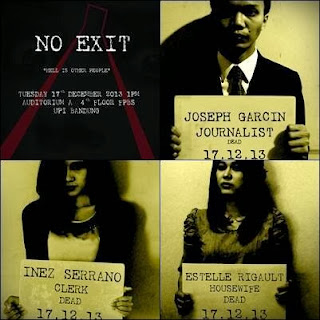"No Exit"
 |
Presented by: English Education A 2010
Place: Audit A, FPBS, UPI
Date: Tuesday, 17 December 2013
Director: Fajar Taufik Nugraha
Casts:
- Nada Ardi Pradhya as Joseph Garcin
- Imel Wahyuni as Inez Serrano
- Suci Maharani as Estelle Regault
- Aseb as Vallet.
Synopsis:
How It All Goes Down
The scene is a drawing room with Second-Empire French furnishings, including three couches and a bronze mantelpiece. Enter through a door a valet and a man named Joseph Garcin. Garcin is extremely surprised at the room’s appearance – it seems he was expecting something very different.
The two of men converse cryptically about this place and the rules (no mirrors, no nighttime, no sleep) while Garcin guesses about the methods of "torture." The valet reveals that, beyond the door, there are simply more passages and more rooms. Odd.
The valet finally excuses himself. Before he exits, he informs Garcin that he can be summoned via the call-button, but that the call-button is temperamental and doesn’t always work.
Garcin lasts about, oh, two seconds alone before trying to summon the valet back. Of course, the call-button doesn’t work. He despairs, but the door soon opens and in walks the valet, bringing with him Inez, a women who, like Garcin, is supposed to stay in this room.
Unlike Garcin, however, she doesn’t have any questions to ask the valet. The valet exits, leaving the two of them alone.
Inez is expecting to see a woman named Florence. When she doesn’t, she concludes that this is "torture by separation." Then she accuses Garcin of being her torturer. Garcin finds this amusing and reveals that, actually, no, he’s not a torturer.
He was a journalist, and now he’s in the same boat as she. At this point they’re basically trying to feel each other out. Garcin is interested in being polite and helping each other as best they can, while Inez thinks they should look after their own interests. Besides, she says, she’s not a polite person.
Then the door opens once more and in walks the valet, again, this time with a third person, Estelle. Estelle immediately freaks out when she sees Garcin, who has his head buried in his hands. She tells him not to look up, since she knows he has no face. When he looks up and reveals that, actually, yes, he does have a face, she’s confused.
It seems she was expecting someone else (and a faceless someone else at that). Meanwhile Inez, who we can safely conclude is gay, has taken an extreme interest in Estelle, who we can safely assume is beautiful.
Estelle is concerned with aesthetics. She wants to sit on a couch with a color to complement her outfit. She wants a mirror to look at herself. She wants everyone to stare at her and think she’s beautiful.
Inez is more than willing to do this, but Garcin is not. This is problematic, as Estelle is interested in the man, not the woman. Much bickering ensues.
At this point in the play, based on hints and suggestions we’ve gotten from the dialogue, we suspect that Garcin, Inez, and Estelle are dead and have found themselves in hell. We know this absolutely when Estelle refuses to hear the word "dead" and instead wants to be called "an absentee" (as in, absent from earth).
Estelle is in denial for much of the play. Inez, on the other hand, wants to face the music. She makes a big deal out of yelling, "We’re in hell!" whenever she can, lest anyone forget. As for Garcin, he generally wants to be left alone. He’s afraid (correctly) that they will only hurt each other if they interact, so he thinks they should sit alone on their couches and not speak. This fails miserably.
While harassing each other and arguing, each of the three characters slowly reveals the story of his or her life. Garcin was a journalist in Rio who ran a pacifist newspaper. He was shot for standing up for his principles.
Estelle was a poor girl whose parents died when she was young. She married a wealthy man three times her age to support her and her younger brother, became a society woman, and died of pneumonia. Inez was a postal worker.
While they speak, each of the three are allowed glimpses of scenes back on earth. Garcin watches his colleague, Gomez, talk about him to their friends. Inez watches her old apartment get closed up and then rented out to someone new. Estelle watches her friend, Olga, flirt with a boy who used to love her. All of them proclaim ignorance as to why they are in hell.
And then the real stories come out. Garcin was a big-time adulterer who used to bring his mistresses home with him for his wife to host in the morning. His wife adored him, but he treated her badly. Estelle carried on an affair with a young man and got pregnant with his child.
She fled to Switzerland so she could have the baby away from the sight of her husband, and then drowned the infant while her lover watched helplessly. Inez lived with her cousin and his wife, Florence. She slowly turned Florence against her husband and then took the woman for herself.
Now that they’ve admitted why they’re in hell, they can start to understand what hell is about. It’s clear that each of them is meant to torture one of the others. Garcin tortures Estelle, because she wants him to love her and think her beautiful, while he refuses to do so. Estelle tortures Inez, because Inez feels an unreciprocated attraction to Estelle.
And finally, Inez tortures Garcin. He wants to be considered a hero, not a coward, and it is Inez’s approval that he seeks (since he has correctly identified that she, not Estelle, knows and understands human emotions and faults).
The three of them are "inseparable," "inextricably linked." On top of the "agony of the human mind," they are allowed no respite from each other, as sleep and nighttime don’t exist here in hell. Consumed with the absurdity of this bleak future, the three characters break into laughter and collapse onto the three couches in the center of the drawing-room.
 |
 |
Pic and Synopsis by @noexit071 @MPL_official



Comments
Post a Comment